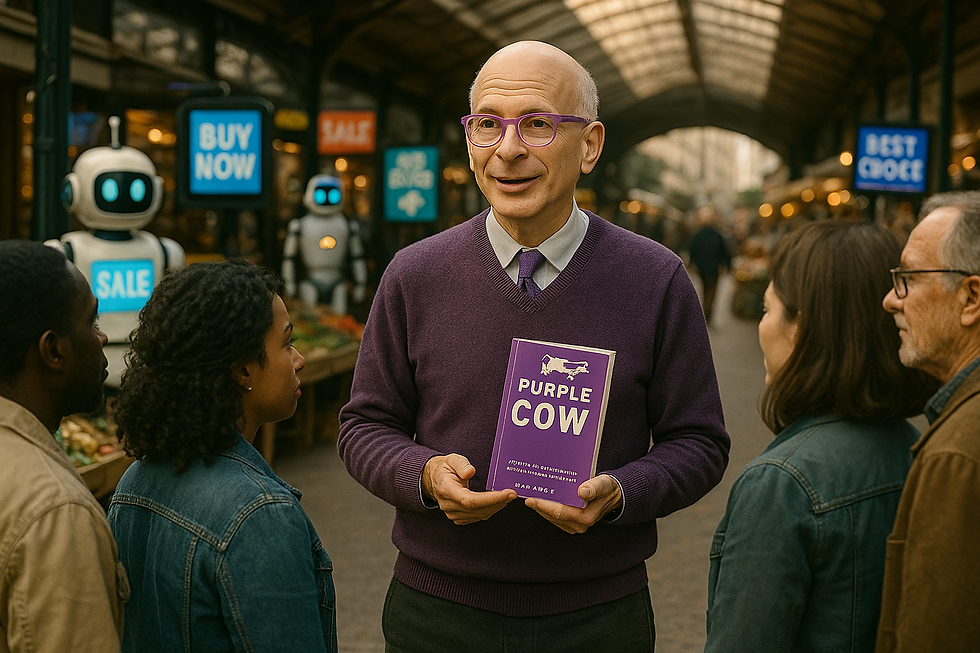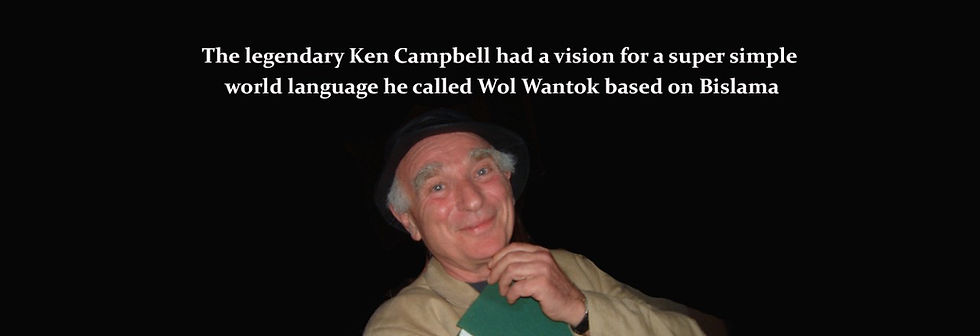Legends of Branding in the Age of AI
- Michael Simkin
- Aug 22
- 13 min read
Updated: Aug 23

Branding has always been about meaning, storytelling and connection. However, technology has dramatically changed how we deliver these things.
In the Mad Men era, great campaigns lived in magazines, newspapers, and on billboards. Later, they spread through TV and mass marketing. Next came the internet, causing a seismic shift in our habits. Today, AI can generate unlimited ads, logos, taglines, and campaigns at breathtaking speed.
What does AI change when it comes to branding?
The first thing is: volume & speed. AI provides content at an industrial scale. The next is personalisation. We now have the ability to create messages that are tailored to micro‑audiences. Meanwhile, automation allows production and distribution with far fewer human hands.
This all sounds great, but it does come with a significant risk, and that is: sameness, overload, and loss of the human spark, as we slowly turn into homogenised robots.
Industry Reality
Major agency groups are restructuring and investing in AI while facing revenue and margin pressure. WPP, once the world’s largest advertising group, saw profits collapse by 71% in early 2025 and is cutting thousands of jobs, even as it invests hundreds of millions in AI.*¹ At the same time, Publicis is holding firm with healthy margins, showing that adaptability matters more than size. *² It’s fair to say that the philosophies of the advertising greats: Ogilvy, Bernbach, Burnett, and the rest are being stress‑tested in real time.
Recently, I’ve been thinking about the greats - the advertising pioneers, the branding thinkers, and the marketing strategists who’ve shaped the commercial world we live in. I've been thinking about their wisdom and wondering how they might have reacted to and used AI. In this article, I look at nine. The first five are no longer living. The final four are alive and kicking, and each reveals a unique perspective about what AI brings to the world of communications.
Why These Nine?
I chose them because they represent three complementary traditions: The Advertising Greats (Ogilvy, Bernbach, Burnett) show how ideas, creativity, and drama can turn campaigns into cultural events. The Branding Greats (Landor, Olins, Aaker) treat brands as identities, systems, and strategic assets. The Marketing Thinkers (Kotler, Godin, Sharp) frame marketing as an economic, cultural and evidence‑based discipline.
Together, they form a broad spectrum, from the imaginative and emotional to the systematic and data‑driven.
Of course, many other giants could have been included here. Lester Wunderman (father of direct marketing). Howard Luck Gossage (the “Socrates of San Francisco,” who believed advertising should be a conversation, not a monologue). Mary Wells Lawrence (the first woman to lead a major Madison Avenue agency, known for theatrical, fearless campaigns). Claude C. Hopkins (Scientific Advertising and early coupon testing). Rosser Reeves (Unique Selling Proposition). Jean‑Noël Kapferer (Brand Identity Prism). Al Ries & Jack Trout (positioning). In a larger work, each of these figures warrants close inspection.
The nine highlighted here form a representative lens through which to examine branding’s founding principles and how those principles collide with AI in today’s industry.
David Ogilvy - Discipline Meets the Big Idea

David Ogilvy (1911-1999) is often called the father of advertising. He built his philosophy around four pillars: 1) Creative Brilliance - the Big Idea. Every great campaign, he believed, rests on one powerful, memorable concept. 2) Research. Advertising should be tested, measured, and grounded in data. 3) Results. “We sell, or else.” Pretty ads meant nothing without impact. 4) Professional Discipline. Ogilvy codified knowledge and trained his teams rigorously.
Although he’s remembered for brand building, Ogilvy leaned heavily into direct response, as it is measurable, accountable and ROI‑focused. He was sceptical of people who “worship at the altar of creativity.”
What would Ogilvy make of AI?
I reckon he’d love its data power and A/B testing. He’d likely embrace hyper‑targeted direct response. However, he’d probably frown at AI’s safe, derivative copy. He might say that ‘without a Big Idea, it’s just noise.’ I guess that ultimately, he would insist that AI be used methodically and not as a gimmick.
Campaigns That Defined Him
Hathaway Shirts (1951): A man in an eye patch made an ordinary shirt iconic. Rolls‑Royce (1958): “At 60 miles an hour, the loudest noise is the electric clock.” Schweppes (1953): “Schweppervescence.”

If Ogilvy gave advertising its discipline, Bill Bernbach gave it its soul by insisting that imagination and simplicity were as important as data.
Bill Bernbach - Creativity as the Last Advantage

Bernbach (1911-1982) revolutionised advertising by putting simplicity and creativity at the centre.
Simplicity. In communications, simplicity means clarity, though it takes great intelligence to cut through the fluff to the essence. Thus, the phrase - it isn’t simple being simple.
Creativity + Humanity. Bernbach saw imagination and originality as the keys to persuasion.
Copy + Art Together. He also pioneered the two‑person creative partnership (copywriter + art director).
Responsibility. Bernbach was aware of the power he held. He said, “We can vulgarise society, or we can lift it onto a higher level.”
What would Bernbach make of AI?
I guess he'd dismiss AI’s average ads as unoriginal. At the same time, his legacy of partnership feels newly relevant: today, many creatives use AI like a junior partner across the desk, and Bill may have accepted AI's usefulness as a creative partner. He’d probably also warn against letting it dominate and allowing our own creative muscles to atrophy.
Campaigns That Defined Him Volkswagen Beetle “Think Small” (1959): Turned a quirky car into an American icon. Avis “We Try Harder” (1962): Humility as strategy. Levy’s Rye Bread (1961): “You don’t have to be Jewish to love Levy’s.”

Where Bernbach spoke to creativity, Leo Burnett spoke to the heart, finding the inherent drama in everyday products and turning them into cultural archetypes.
Leo Burnett - Finding the Inherent Drama

Burnett (1891-1971) championed the soft sell. He believed it was vital to find the product’s own inherent drama and to express it with warmth and shared emotion, using cultural archetypes.
Warmth & Shared Emotions. Burnett understood these were rooted in family, community and values - our common language and conditioning.
Simple, Strong Imagery. He knew the power and importance of speaking directly and instinctively.
Cultural Archetypes. He understood the value of creating mascots and was famous for inventing the Jolly Green Giant, Tony the Tiger, the Pillsbury Doughboy, and the Marlboro Man.
What would Burnett make of AI?
He may well have been sceptical of the ability of AI to touch hearts. He may have been willing to use AI to sketch visual ideas, but he probably would have believed that humans must find the real drama. I can imagine him saying that archetypes live in culture, not in code.
Campaigns That Defined Him
Marlboro Man (1954): Made a women’s cigarette brand into a masculine icon. Tony the Tiger (1952): “They’re grrreat!”#
Jolly Green Giant (1954): Mythic abundance Pillsbury Doughboy (1965): Family comfort, playfully personified.

While Burnett filled the airwaves with characters, Walter Landor quietly built the discipline of identity, proving that brands live not just in advertisements, but in the minds of consumers.
Walter Landor - Brands Live in the Mind

Landor (1913-1995) believed that design had to function like a public utility - it had to be something that serves people broadly, much like electricity, water, or transit does. Its purpose was to create resonance with millions of people, meaning design should connect emotionally, make sense intuitively and feel appropriate to its context.
He talked about developing five habits: look critically, listen deeply, be articulate, trust intuition, and develop a “third eye” for what will resonate at scale.
What would Landor make of AI?
He would likely have welcomed AI for its ability to conduct rapid iteration and testing. He might also caution us that appropriateness beats novelty and that identity must fit context. Landor understood that a design that’s flashy or novel but doesn’t make sense for the company’s identity is a failure. He might say: Don’t chase gimmicks just because AI can generate them. The acid test is whether the brand identity still feels appropriate, relevant, and meaningful in its real-world context. Also, despite AI’s power to analyse and generate, the deeper instinct of humans is something machines can’t replace. Judgment, intuition, and cultural sensitivity still belong to people.
Identities That Defined Him
FedEx (1994): Wordmark with the hidden arrow. BP (2000): The “Helios” rebrand. Coca‑Cola (80s-90s): Packaging and identity refinements GE (late 80s): updated visual identity system Levi’s (80s), Japan Airlines (1959), Shell (70s-80s)

If Landor designed the systems, Wally Olins tested them against culture, showing that brands are what organisations do, not just what they show.
Wally Olins - Branding as Behaviour & Belief

Olins (1930–2014) argued that a brand is not just a logo or visual wrapper but the lived expression of an organisation’s traits, vision, and behaviour. He insisted that brand identity is culture made visible. He also believed that a company’s values and actions are reflected in how people perceive it. For him, a brand’s true value was emotional resonance: how it makes people feel, not just how it looks.
A brand as an asset. Olins believed that brand identity is behaviour, not decoration. It is a vital asset that differentiates companies in crowded markets.
Critique. He encouraged us to avoid corporate wishful thinking and cosmetic branding.
Emotion. He said that a brand lives or dies by the feelings it creates in its audience.
What would Olins make of AI?
For one thing, Olins may well have mocked AI logo generators as shallow. At the same time, he might have used AI for perception analysis and listening to culture. He might also have warned us that if a company lies, cheats, or borrows, no AI toolkit can save it.
Identities That Defined Him
BT (1991, 2003): From state utility to consumer brand. Orange (1994): Brand launch, UK Tata Group (1997-2000): Unified India’s largest conglomerate. Nation Branding: Poland (2003), Portugal (mid-2000s), Spain (early 2000s).

Olins made brands cultural, but David Aaker made them measurable—codifying brand equity and architecture into tools leaders could use.
David Aaker - The Strategist of Brand Equity

Aaker, born in 1938, is sometimes known as the “Father of Modern Branding.” He gave us frameworks to measure and manage brands as assets.
Brand Equity Model: Aaker’s model allows us to measure awareness, loyalty, and their associations.
Brand Identity System: He also created a system that identified brands through four perspectives: Product, Organisation, Person, Symbol Brand Architecture: Aaker also showed how brands can best fit together in portfolios.
What does Aaker make of AI?
Well, he’s 87, so I didn’t want to bother him by asking. I would respectfully guess that he might see AI as a powerful way to take measurements. He may caution that, given brand identity is multi‑dimensional, we should be careful about accepting potentially wrong conclusions drawn by AI. He might also warn us that AI belongs inside the system, not in charge of it.
Contributions That Defined Him Managing Brand Equity (1991). Building Strong Brands (1996). Brand Portfolio Strategy (2004).

Aaker gave brand managers their frameworks; Philip Kotler gave marketers their playbook, transforming marketing into a systematic business science.
Philip Kotler - The Systematizer of Marketing

Kotler, born in 1931, is credited with making marketing central to business, linking it to economics, communications and customer psychology.
Marketing as Economics: Kotler has shown that demand is shaped not just by price, but by a network of forces: advertising, promotion, distribution and perception.
Customer‑Centricity: His philosophy rests on the core belief that successful marketing begins with understanding and satisfying human needs and wants. Beyond Selling: Kotler broadened marketing beyond selling products, applying it to nonprofits, the arts, politics and even social causes. It is he who introduced concepts like societal marketing and demarketing (a marketing strategy used to discourage consumption of a product, e.g smoking). The 4Ps: Kotler also gave structure to the discipline through the “4Ps” - Product, Price, Place, & Promotion, which remain a foundation of marketing practice.
What might Kotler make of AI?
Philip Kotler sees AI as a transformative force for marketing. He explores this in his more recent books, such as Marketing 5.0: Technology for Humanity, where he frames AI's role in an ethical and philosophical context.
Kotler believes AI can significantly improve the work of human marketers, but it cannot replace them. By automating tasks like data analysis and customer service (e.g., with chatbots), he suggests that AI has the power to successfully free up humans for more complex, creative, and empathetic work.
Kotler highlights two key applications of AI:
Data and Personalisation: He suggests that AI's power lies in analysing vast data to create highly personalised marketing campaigns at scale.
Predictive Analytics: He values AI for its ability to forecast the success of a marketing strategy before it's even launched, helping to optimise campaigns and avoid failures.
Kotler also acknowledges generative AI, seeing it as a way to increase efficiency and content creation, but stresses the need for marketers to use these tools responsibly and authentically. He believes that technology must serve humanity, with customer needs remaining the central focus
Contributions That Defined Him Marketing Management (1967). Principles of Marketing (1980) Kotler on Marketing: How to Create, Win, and Dominate Markets (1999) Strategic Marketing for Nonprofit Organizations (2003) Purple Cow (2003) Marketing 3.0 (2010) Marketing 4.0 (2016) Marketing 5.0 (2021)

Kotler worked at scale, but Seth Godin turned the lens to the intimate, exploring: permission, authenticity, and tribes as the true engine of connection.
Seth Godin - Permission, Tribes & the Purple Cow

Godin (1960– ) has revolutionised marketing by rejecting the typical tendency of interrupting customers to get their attention, focusing instead on offering service. For him, marketing is the generous act of helping someone solve a problem, not pushing messages.
Permission Marketing. Godin realised that instead of grabbing attention, companies can earn trust by gaining consent.
Remarkability. He suggests that playing it safe leads to being invisible. He suggests we create products and ideas worth talking about - he used the phrase Purple Cow to point to this.
Tribes: Godin says that success lies in nurturing communities built on shared values, not chasing mass markets.
Authenticity & Storytelling. For him real connection happens when brands tell honest stories that resonate emotionally.
What does Godin make of AI?
Godin has spoken widely about AI, and there is no need to speculate. Here are a few of his key statements.
“I think AI is the biggest change in our world since the invention of electricity – a bigger change than the internet. If you’re not using it for half an hour a day, you don’t understand. You need to put it on your calendar and go use it.” *³
Godin sees the impact of AI as on par with electricity itself.
“If you are simply mediocre, I can get an AI to do it cheaper and faster than you.” *⁴
Basically, we have to figure out how to do something that AI couldn’t do because that’s the only thing worth charging for.”
“For true creatives, AI can be a new way to break out of the ordinary.” *⁵ Godin nails the existential challenge for creatives: AI can do average, whereas distinctiveness remains human turf.

If Godin speaks to meaning, Byron Sharp snapped us back to evidence - showing through data that growth comes not from loyalty, but from reach and availability.
Byron Sharp - Growth Through Availability

Byron Sharp (b. 1968), director of the Ehrenberg-Bass Institute and author of How Brands Grow (2010), redefined modern marketing by grounding it in empirical evidence rather than tradition.
Penetration Over Loyalty. Sharp shows us that brands grow by acquiring new buyers, rather than by over-investing in customer retention.
Mental & Physical Availability. He reveals that success requires being easy to recall (distinctive brand assets) and easy to buy (broad distribution).
Evidence Over Myth. Sharp boldly challenges sacred cows of marketing like loyalty programs and narrow targeting.
What does Sharp make of AI?
Sharp stresses that AI, like any tool, must be judged by results, not hype. For him, the keys to brand growth remain the same: penetration over loyalty, and mental and physical availability. AI may help with media buying, personalisation, and data handling — but it cannot replace the core drivers of distinctiveness and reach.
At the Ehrenberg-Bass Institute, Sharp positions AI as a useful amplifier of measurement. On his LinkedIn feed, he notes that AI tools can already match traditional market research with 90%+ accuracy, potentially surpassing it in speed and reliability. *⁶ Still, he cautions that however advanced the technology becomes, the requirements of salience and availability remain non-negotiable.
As Sharp himself put it:
“AI can match market research with 90%+ accuracy.” *⁶
“In a world of constant marketing ‘disruption,’ the fundamentals still matter more than ever.” *⁷
The message is clear: AI may change the tools, but not the rules.
Contributions That Defined Him
How Brands Grow (2010). Distinctive Brand Assets research. Ongoing work at the Ehrenberg‑Bass Institute.

Sharp’s evidence leaves us with a hard‑nosed view of growth. But placed alongside Ogilvy’s discipline, Bernbach’s creativity, Burnett’s archetypes, Landor’s identity, Olins’ culture, Aaker’s frameworks, Kotler’s systems, and Godin’s tribes, a fuller picture emerges, one that shows how each philosophy collides with AI in its own way.
Conclusions
Across these nine, the thread is clear: while tools and channels change, branding still lives at the intersection of meaning, memory, and behaviour. Each thinker staked out a different tension: Ogilvy’s discipline vs. Bernbach’s imagination, Burnett’s archetypal warmth vs. Landor’s identity systems, Olins’ culture vs. Aaker’s frameworks, Kotler’s economics vs. Godin’s tribes, and Sharp’s evidence vs. industry myth.
It’s also worth remembering that the first five: Ogilvy, Bernbach, Burnett, Landor, Olins - are no longer with us. They were born into a simpler, slower media world, and they left their mark through visible work: landmark campaigns and identities that entered popular culture.
The living four: Aaker, Kotler, Godin, and Sharp changed the field more through books and frameworks than advertising campaigns. Their “campaigns” are ideas: codifying brand equity, modern marketing, permission and tribes, and evidence-based growth.
AI now arrives as a powerful tool, challenge and amplifier. It can accelerate research, optimise media, and scale personalisation. Yet the foundations remain: as Sharp argues, growth still comes from penetration and availability; as Godin insists, trust and permission can’t be automated; as Kotler teaches, marketing begins with human needs; and as Aaker reminds us, identity is a multi-dimensional system, not a dashboard.
From the earlier era, Ogilvy’s Big Idea, Bernbach’s human imagination, Burnett’s inherent drama, Landor’s appropriateness, and Olins’ culture-as-behaviour remain the guardrails.
Vision forward: the next chapter belongs to leaders who blend the bold, culture-shaping daring of the early campaigners with the clarity and discipline of the modern frameworks—using AI not to replace creativity, but to magnify it.
In doing so, brands must widen the lens: factoring in not just profit, but also our planet and people. If the five who’ve gone taught us how to make brands felt in the world, and the four who are alive teach us how to think about brands as systems, then our task is to unite both: build brands that are easy to buy and impossible to forget, and that still feel unmistakably human, because the future of branding is not only about growth, but about responsibility and resonance with life itself. If you would like to have a chat about how I may be able to help you do that, drop me a line.
Sources
*2
*3
*4
*5
*6
*7https://www.marketingmag.com.au/featured/what-byron-sharp-taught-us-about-the-future-of-marketing/?utm_source=chatgpt.com





Comments